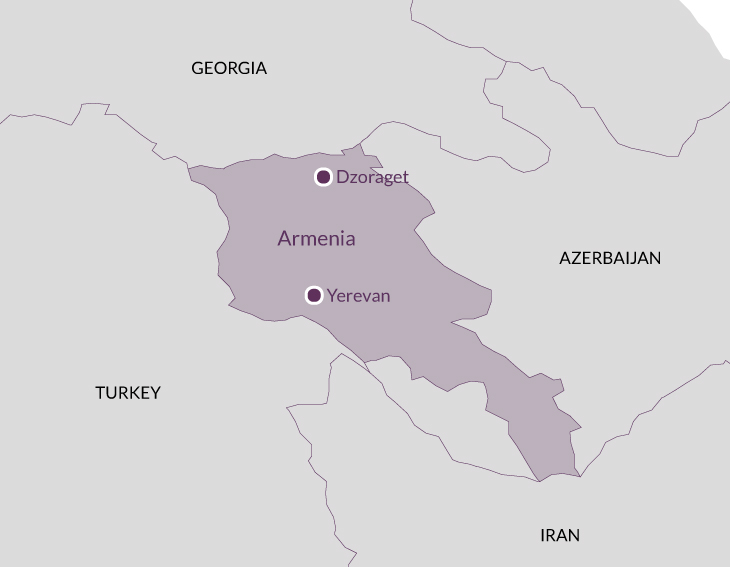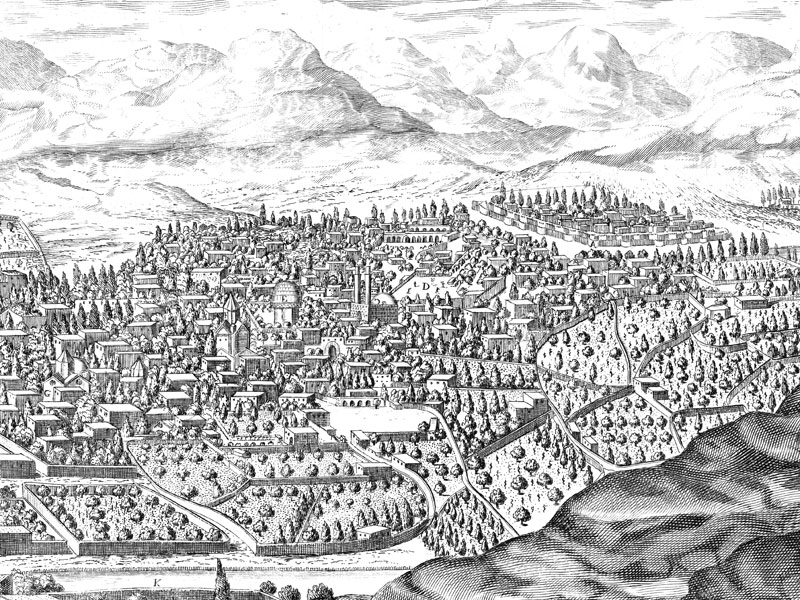Overview
Of all the lands straddling east and west, the nation of Armenia is perhaps least like a gateway and most like a frontier. ‘Unique’ is a lazy and unenlightening epithet with which to characterise distant lands, but Armenia, both ancient and modern, Asian and European, melting-pot and defiantly individual, is fully deserving of the description. Its long and tenacious history is one of tragedy and renewal. The heralding this spring of a ‘New Armenia’, following a peaceful uprising led by Nikol Pashinyan against corruption and single-party rule, signals the latest upward curve.
At its apogee in the first century bc, Armenia stretched from the Mediterranean to the Caspian, and almost to the Black Sea. For the next three centuries, however, it would suffer conquest and reconquest as the Romans and the Parthians traded blows in the southern Caucasus, with intermittent periods of self-rule keeping the flame of independence alive.
It was in large part to keep themselves distinct from the two vast surrounding empires that the Armenians adopted the new religion of Christianity in ad 301, developing a new alphabet a hundred years after that. These two markers of identity survived domination by Byzantines, Arabs, Mongols, Turks and Russians, as did many spectacular religious buildings, which were built to withstand not just invasions but earthquakes too.
Armenia’s sacred architecture was a greater influence on medieval Europe than is commonly assumed, after its round towers and cross-plans were noted by returning crusaders. Thick-walled, built from local tuff or basalt, and housing a particularly severe strain of eastern Christianity, there is a resplendent austerity about these churches which is only heightened by their frequently spectacular natural surroundings.
Many of the finest, including the rock-hewn Geghard and the unesco world heritage site of Echmiadzin, are easily visited from the capital, Yerevan. And while calling Yerevan the most sensitively-remodelled of all former Soviet cities may sound like damnation with the faintest praise imaginable, today it is attractive and confident, its proliferation of cafés, galleries and public spaces making it a truly pleasant place to spend time. In the north of the country are two more unesco-listed monasteries, at Sanahin and Haghpat; both tell the story of Armenian religion and cultural endurance.
Meanwhile Yerevanis live, work and socialise in the literal and metaphorical shadow of Ararat, still Armenia’s most emotive symbol despite now being on Turkish land.
A few hundred yards from the border, the monastery of Khor Virap, which proudly boasts the dungeon where St Gregory the Illuminator was incarcerated, defiantly advertises the indomitable Armenian Christian tradition.
Day 1
Fly at c. 9.00am from London Heathrow to Yerevan via Paris (Air France), arriving c. 8.25pm. Transfer to the hotel in the heart of the city.
Day 2
Yerevan. A leisurely start this morning. The day begins with a visit to the comprehensive and fascinating State Museum of Armenian History. At the National Art Gallery see collections from Armenia, Russia and Western Europe. Overnight Yerevan.
Day 3
Echmiadzin, Yerevan. In the morning, visit the Matenadaran, a repository of 17,000 illuminated manuscripts. The Museum of the Armenian Genocide is all the more powerful for its simplicity. After lunch, drive to Echmiadzin, the seat of the Armenian Apostolic Church, also a unesco world heritage site. The vast ruined cathedral at neighbouring Zvartnots tells of the extraordinary ambition of early architects. Overnight Yerevan.
Day 4
Amberd, Dzoraget. The ruins of Amberd Fortress, dramatically located on the southern slopes of Mount Ararat, date back to the 12th century, although it has been a stronghold since the seventh. In the afternoon, drive to Dzoraget. First of two nights here.
Day 5
Akhtala, Alaverdi. The 13th-century frescoes in Akhtala are strongly influenced by Byzantium. The monasteries at Haghpat and Sanahin, both unesco-listed sites, are both fine examples of Armenian sacred architecture. Overnight Dzoraget.
Day 6
Vanadzor, Dilijan, Lake Sevan. Visit a stone-carver who continues the tradition of cutting khachkars (cross-stones), characteristic of Medieval Christian Armenian art. Drive to Lake Sevan, and the peerlessly situated Sevanavank monastery that overlooks it. Overnight Yerevan.
Day 7
Khor Virap, Noravank, Yerevan. Visit the Khor Virap monastery in the foothills of Mount Ararat, where St Gregory the Illuminator was imprisoned. Hidden from view in a remote valley, Noravank, the masterwork of the architect and sculptor Momik, is perhaps the most beautiful of Armenia’s 13th-century monasteries. Overnight Yerevan.
Day 8
Geghard, Garni. Much of the monastery at Geghard is carved out of the cliffside. There is a performance here of the Armenian Divine Lithurgy by Luys Quintet. The Hellenic temple at Garni is the last remaining pre-Christian building in Armenia.
Day 9
The morning flight from Yerevan arrives Heathrow at c. 1.45pm.
If combining this tour with Georgia Uncovered, fly from Yerevan to Tbilisi at c. 3.50pm (Georgia Airways) and transfer by taxi to the hotel.
Price, per person
Two sharing: £3,750 or £2,960 without flights. Single occupancy: £4,180 or £3,390 without flights.
Price, Sacred Armenia and Georgia Uncovered combined
Two sharing: £7,550 or £7,150 without flights. Single occupancy: £8,590 or £8,190 without flights. This includes flight and airport transfers between the two.
Included
Flights (economy class) with Air France: return London to Paris (Airbus A321) and Paris to Yerevan (Airbus A320); accommodation as described below; travel by private air-conditioned coach throughout; breakfasts, all lunches and all dinners with wine, water and coffee; all admission to museums, churches and sites; all tips for restaurant staff, drivers and guides; all state and airport taxes; the services of the lecturer and a local guide.
Visas
British, EU, US, Australian and New Zealand nationals no longer require a visa. Passports must be valid for at least six months after the tour ends.
Accommodation
Grand Hotel, Yerevan: In a 1920s Neo-Classical-style building, close to Republic Square, this luxury hotel was fully renovated in 2015. It has spa facilities and a roof-top swimming pool with panoramic views. The Avan Dzoraget: a small and stylish hotel in a wonderful riverside location, equivalent to a 4-star. Single rooms are doubles for sole use throughout.
How strenuous?
You will be on your feet for long periods. Many of the sites are reached by steep, uneven steps often without handrails. There are 220 steps to a monastery. The tour would not be suitable for anyone who has difficulties with everyday walking and stairclimbing. There are 4 coach journeys of over 2 hours (average distance by coach per day: 72 miles).
Are you fit enough to join the tour?
Group size
Between 10 and 22 participants.
Travel advice
Before booking, please refer to the FCDO website to ensure you are happy with the travel advice for the destination(s) you are visiting.

'We were really most impressed with the quality and the synergistic collaboration show by the tour manager and lecturer, they enjoyed working together and it showed.'
'My first tour with Martin Randall Travel - I will be back!'
'Another memorable holiday. You have spoiled me from going with other companies.'
'This itinerary was a valuable addition to the MR list.'
'A very high standard was achieved. I learned a lot in relative comfort and with real pleasure.'
